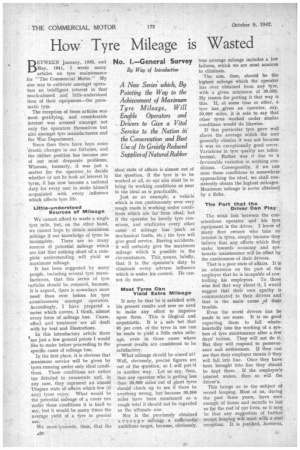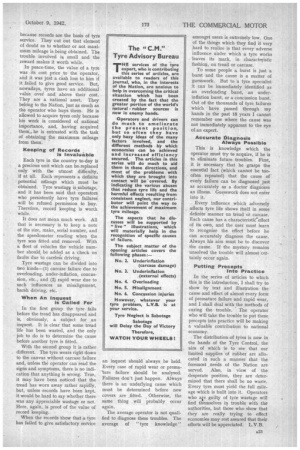How Tyre Mileage is Wasted
Page 22

Page 25

If you've noticed an error in this article please click here to report it so we can fix it.
No. I.—General Survey
By Way of Introduction
A New Series' which, By Pointing the Way to the Achievement of Maximum Tyre Mileage, Will Enable Operators and Drivers to Give a Vital Service to the Nation in the Conservation and Best Use of Its Gretly Reduced Supplies of Natural Rubber
4 ETWEEN January, 1938, and
May, 1941, I wrote many articles on tyre maintenance for " The Commercial Motor." My aim was to cultivate amongst operators an intelligent interest in that much-abused and little-understood item of their equipment—the pneumatic tyre.
The reception of these articles was most gratifying, and considerable interest was aroused amongst not only the operators themselves but also amongst tyre manufacturers and the War-Department.
Since then there have been some .drastic changes in our fortunes, and the rubber position has become one of our most desperate problems. Whereas, formerly, it was just a matter for the operator to decide whether or not he took an interest in tyres, it has now become a national duty for every user to make himself acquainted with every influence which affects tyre life.
Little-understood Sources of Mileage
We cannot afford to waste a single tyre mile, but, on the other hand, we cannot hope to obtain maximum mileage if our knowledge of tyres be incomplete. There are so many sources of potential mileage which are lost that nothing short of a complete understanding will yield us maximum mileage.
It has been suggested by many people, including several tyre manufacturers, that this series of tyre 'articles should be resumed, because, it is argued, there is nowadays more need than ever before for tyre c onsciousness amongst operators. Accordingly, I have prepared a series which covers, I think, almost every form of mileage loss. Cause, effect and treatment are all dealt with by text and illustrations.
In this introductory article there are just a few general points I would like to make before proceeding to the specific cases of mileage loss.
In the first place, it is obvious that maximum .service will he given by tyres running under only ideal conditions. These conditions are rather too detailed to enumerate and, in any case, they represent an almost Utopian state of affairs which few (if any) tyres enjoy. What would be the potential mileage of a cover run under these conditions it is hard to say, but it would be many times the average yield of a tyre in general use
We must ,oncede, then, that the A20 ideal state of affairs is almost out of the question, if the tyre is • to be worked at all, so our aim Must be to bring its working conditions as near to the ideal as is practicable. Just as an example, a vehicle which is run continuously over very rough roads is working under conditions which are far from ideal, but if the operator be keenly tyre conscious, and eradicates every' other cause of mileage loss (such as mechanical faults, etc.) the tyre will give good service. Barring accidents, it will certainly give the maximum mileage which is possible in the circumstances. This means, briefly, that it is the operator's duty to eliminate every adverse influence which is under his control. He cannot do more.
Most Tyres Can Yield Extra Mileage
It may be that he is satisfied with his present results and sees no need to make any effort to improve upon them. This is illogical and unpatriotic. It is a safe bet that 95 per cent. of the tyres in use can be made to yield a little extra mileage, even in those cases where present results are considered to be satisfactory.
What mileage should be aimed at? Well, obviously, precise figures are out of the question, so I will put it in another way. Let us say, then, that any operator who is getting less than 30,000 miles out of giant tyres should check up to see if there be anything wrong, but because 30,000 .miles have been mentioned as a rough total it should not be regarded as the ultimate aim.
Nor is the previously obtained a veragemileagea sufficiently.ambitious target, because, obviously,
true average mileage includes a few failures, which we are most anxious to eliminate.
The aim, then, should be the highest mileage which the operator has ever obtained from any tyre, with a given minimum of 30,000. My reason for putting it that way is this. If, at some time or other, a tyre has _given an operator, say, 50,000 miles, it is safe to say that other tyres worked under similar conditions would do likewise.
If this particular tyre gave well above the average which the user generally obtains it was not because it was an exceptionally good cover. Variations in tyre quality are infinitesimal. Rather was it due to -favourable variation in working conditions. Consequently, if we can raise these conditions to somewhere approaching the ideal, we shall consistently obtain the highest mileages. Maximum mileage is never obtained by a fluke.
The Part that the Driver Can Play
The weak link between the conscientious operator and his tyre equipment is the driver. I know of many fleet owners who take no interest in tyres, simply because they believe that any efforts which they make towards economy and systematic maintenance will be offset by. the carelessness of their drivers.
That is a poor state of affairs. It is an admission on the part of the employer that he is incapable of controllinghis employees. To . those who feel that way about it, I would suggest that their own apathy is communicated to their drivers and that is the main cause of their trouble.
Even the worst drivers can be made to see sense. It is no good expecting them to fall wholeheartedly into the working of a system of tyre maintenance after a few days' tuition. They will not do it. But they will respond to perseverance and enthusiasm. If they can see that their employer means it they will fall into line. Once they have been brought into line they should be kept there. If the employer's interest wanes, then so will the d river's.
This brings us to the subject of record keeping. Most of us, during the past three years, have seen enough of forms and records to last us for the rest of our lives, so it may be that any suggestion of further record keeping will meet with a ebol reception. It is justified, .however, because records are the basis of tyre service. They cut out that element of doubt as to whether or not maximum mileage is being obtained. The trouble involved is small and the reward makes it worth while.
In peace-time, the value of a tyre was its cost price to the operator, and it was just a cash loss to him if it failed to give good service. But, nowadays, tyres have an additional value ovei and above their cost. They are a national asset. They belong to the Nation, just as much as the operator who buys them. He is allowed to acquire tyres only because his work is considered of national importance, and, having acquired them„ he is entrusted with the task of obtaining the maximum mileage from them.
Keeping of Records Is Invaluable Each tyre in the country to-day is a precious unit which can be replaced only with the utmost difficulty, if at all. Each represents a definite potential mileage which must be obtained. Tyre wastage is sabotage, and it has been said that operators who persistently have tyre failures will be refused permission to buy. Therefore, record keeping is worth while.
It does not mean much work. All that is necessary is to keep a note of the size, make, serial number, and the speedometer reading when the tyre was fitted and removed. With a fleet of vehicles the vehicle number should be added as a 'check on faults due to careless driving.
Tyre wastage can be divided into two kinds—(1) carcase failure due to overloading, under-inflation, concussion, etc., and (2) rapid wear due to such influences as misalignment, harsh driving, etc.
When An Inquest is Called For
In the first group the tyre fails before the tread has disappeared and is, obviously, a _subject for an inquest. It is clear that some tread life has been wasted, and the only job to do is to determine the cause before another tyre is fitted.
With the second group it is rather different. The tyre wears right down to the canvas without carcase failure and, unless the operator can read the signs and symptoms, there is no indication that anything is wrong. True, it may have been noticed that the tread has worn away rather rapidly, but, unless records have been kept, it would be hard to say whether there was any appreciable wastage or not. Here, again, is proof of the value of record keeping.
When the records show that a tyre has failed to give satisfactory serVice an inquest should always be held. Every case of rapid wear or premalure failure should be analysed. Failures don't just happen. Alivays there is an underlying cause which must be determined before new covers are _fitted. Otherwise, the same thing will probably occur again. The average operator is not qualified to diagnose these troubles. The average of "tyre knowledge" amongst users is extremely low. One of the things which they find it very hard to realize is that every adverse influence under which a tyre works leaves its mark, in charactelistic fashion, on tread or carcase.
To some people a burst is just a burst and the cause is a matter of guesswork. But to 'a tyre specialist it can be immediately identified as an overloading burst, an underinflation burst, or a concussion burst. Out of the thousands of tyre failures which have passed through my hands in the past 18 years I cannot remember one where the cause was not immediately apparent to the eye of an expert.
Accurate Diagnosis
Always Possible
This is knowledge which the operator must try to acquire, if he is to eliminate future troubles. First, it is necessary that he grasps the essential fact (which cannot be toooften repeated) that the cause of' evety failure can be diagnosed just as accurately as a doctor diagnoses an illness. Guesswork does not enter into it.
Every influence which adversely affects tyre life shows itself in some definite manner on tread or carcase. Each cause has a characteristie.effect of its own, and the user must learn to recognize the effect before he can accurately diagnose the cause. Always his aim must be to discover the cause. If the mystery remains unsolved the trouble will almost certainly occur again.
Putting Precepts Into Practice
In the series of articles to which this is the introduction, I shall try to show by text and illustration the cause and effect of almost every form of premature failure and rapid wear, and I shall deal with the methods of curing the trouble. The operator who will take the trouble to put these precepts into practice will be making a valuable contribution to national economy.
The distribution -of tyres is now in the hands of the Tyre Control, the aim of whiCh is to see that our limited supplies of rubber are allocated in such a manner that the foremost .needs of the Nation are served. Also, in view of the desperate position, they are determined that there shall be no waste. Every tyre must yield the full mileage which is built into it. Operators who ale guilty of tyre wastage will find themselves in trouble with the authorities, but those who show that they are really trying to effect economies may rest assured that their efforts will be appreciated. L.V.B.




















































